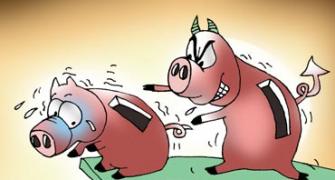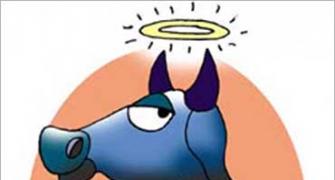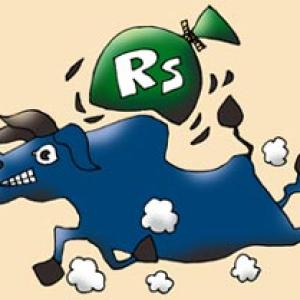Devangshu Datta believes you should pick stocks trading at much lower valuations than the market average.

Equity valuation is a game, not a science and what's more, it has shifting goalposts.
When sentiment is strong, valuations are optimistic.
Absurdities are justified by tweaking timeframes and assumptions.
When sentiment is weak, undervalued stocks with good prospects are shunned. Right now, sentiment is strong.
The National Stock Exchange's Nifty is running at a price-to-earnings (PE) ratio of 25-plus.
The mid-cap indices are running at a PE of 30-plus.
These are exceedingly high valuations in historical terms and justified by assertions that earnings will pick up in the second half of 2017-2018 and in 2018-2019.
All valuation measures suggest India is massively overvalued.
Some common measures for valuation involve the PE or some variation of PE, such as Cash PE (where cash = earnings plus depreciation).
Starting 2014-2015, this is the fourth financial year in a row when projections have been high and reality has disappointed.
The past three financial years have seen earnings growth in single digits and the first quarter of this financial year has been poor.
Consolidated net profits have dropped 15 per cent for 2,100-odd companies that have declared results so far, according to a CARE Ratings study.
Net sales growth slowed to 8.7 per cent for this large sample.
For the 46 Nifty companies that had declared results till last week, the net profit is flat.
It's worth noting these are lows compared to a low base.
A PE of 25, or more, can be justified if net profit is expected to grow at around the same pace of about 25 per cent.
The so-called PE-to-growth (PEG) ratio is reasonable so long as PEG is below 1, and equity is reckoned fairly priced at a PEG of 1.
But not even the wildest optimists are expecting the Nifty earnings to grow at 25 per cent this financial year, even with a second-half pick-up.
Hopes are now fixed on 2018-2019.
Mid-caps are more overpriced than large stocks.
Relatively smaller stocks can see faster growth.
However, a 30 per cent earnings per share (EPS) growth or better is required to justify the current mid-cap valuations.
That sort of growth is very unlikely to happen to hundreds of stocks.
A second method of validating PE ratio is to compare it to risk-free debt returns.
It's reasonable to hope earnings-over-price (the inverse of the PE) will have yields greater than the risk-free return.
For example, with a debt-yield of 10 per cent, the earnings over price should be say, 11 per cent.
Hence, the PE should be at 9 or lower.
With a debt-yield of 5 per cent, the PE could be 19.
The lower the debt-yield, the lower the desirable earnings/price ratio and the higher the sustainable PE by this measure.
A PE ratio of 25 works out to an earnings yield of 4 per cent, while a PE ratio of 30 works out to an earnings yield of 3.4 per cent.
The 364-day Treasury Bill is trading at a yield of 6.25 per cent.
Commercial rates are considerably higher than the T-Bill.
Going by debt yields, the market PE should be in the range of PE 14 to 18. Again this metric suggests major overvaluation across the board.
Many investors also look at the historical price-to-book value (PBV) and dividend yield.
The PBV for the Nifty is currently at 3.5. The dividend yield (dividend as a percent of price) is hovering under 1 per cent.
The long-term median PBV for the Nifty over the past 10 years is about 2.7, while the median dividend yield is about 1.5 per cent.
Again, this seems like over-valuation.
Market valuations tend to revert to near the median unless there's some extraordinary change in the fundamentals. That change is what the optimists are betting on.
The goods and services tax is expected to eventually add considerably to corporate profitability and growth prospects.
However, the timeframe could be quite distant and it's already obvious that this GST implementation has large problems.
There's a working capital squeeze, and a consumption squeeze damaging demand, which was already low.
Government expenditure will be hard to expand, too.
The Centre must compensate states for their loss of sales tax revenue and recapitalise banks, apart from staying in control of the fiscal deficit.
Under the circumstances, it would be prudent to pick stocks trading at much lower valuations than the market averages. Those aren't easy to find.
Photograph: PTI Photo









